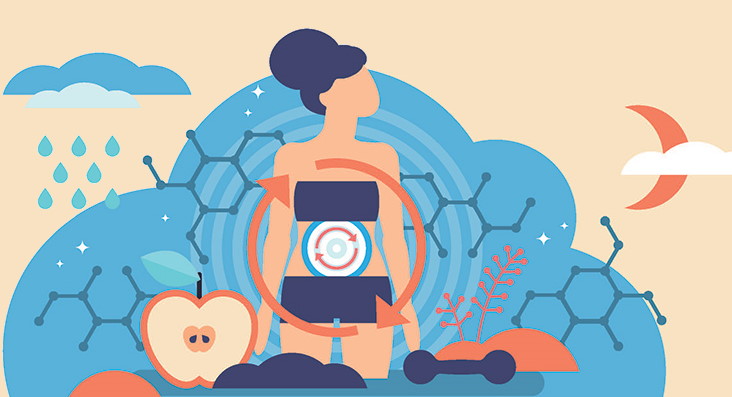Those Lovely ‘Mones: The Intersection of ADHD and Hormones
Linda Roggli
Attention Magazine December 2021
Download PDF
There has been much discussion lately about the relationship between hormones and ADHD symptoms. The key word here is “discussion” rather than “knowledge.” There are a few tantalizing scientific studies that link hormones with neural connectivity in the ADHD brain and subsequent ADHD symptoms. Their precise influence and mechanisms of action are mostly mysteries yet to be unlocked. However, a few farsighted researchers have opened the door just a crack so we can take a quick peek at the possibilities.
 There are more than fifty hormones hard at work in the human body—insulin, growth hormone, melatonin, adrenaline—but only a handful are implicated in ADHD to date. These chemical compounds circulate around and through our bloodstream and organs. When a particular hormone meets up with its matching chemical partner receptor in a particular cell, the receptor/hormone combo swings into action, switching on or off highly important biological processes.
There are more than fifty hormones hard at work in the human body—insulin, growth hormone, melatonin, adrenaline—but only a handful are implicated in ADHD to date. These chemical compounds circulate around and through our bloodstream and organs. When a particular hormone meets up with its matching chemical partner receptor in a particular cell, the receptor/hormone combo swings into action, switching on or off highly important biological processes.
Best known are the sex hormones: estrogens such as estradiol, progestins such as progesterone, and androgens such as testosterone. Men and women have all three sex hormones functioning in their bodies, all of which may impact ADHD. But there are others in play as well.
Cortisol
Cortisol, for instance, is often recognized as the “stress hormone” since it kicks into gear when danger or perceived pressure is present. Cortisol receptors are found throughout the body, so specialized cortisol receptors activate different body functions; for example, raising blood pressure and/or temporarily shutting down nonessential functions such as digestion and growth to divert more energy to muscles when fleeing from danger.
Adults with ADHD report higher subjective levels of stress in daily life, which might imply higher cortisol levels. By contrast, at least one study reports that cortisol levels are virtually identical in ADHD and non-ADHD subjects immediately after stress. The exception was for adults with inattentive ADHD, who showed a higher level of cortisol during testing. According to research by King, Barkley, et al, normal cortisol response is actually blunted when ADHD stress has been present for more than one year.
The normal daily progression of cortisol begins with a fast rise in levels within thirty to forty-five minutes of awakening in the morning followed by declining levels in the evening. A 2021 study of ADHD youth showed a paradoxical effect: lower cortisol in the morning and higher cortisol at night. This upside-down pattern parallels cortisol levels of non-ADHD nighttime workers. The complex circadian rhythm often seen in tandem with ADHD may explain the difference, but which came first, the ADHD night owl tendencies or the ADHD cortisol boom in the wee hours? No answers yet.
Thyroid
Thyroid hormones play an important role in brain development. Young children with thyroid-stimulating hormone (TSH) levels in the high-normal range were more likely to demonstrate ADHD symptoms.
Researchers have observed an association between disrupted thyroid levels in a pregnant mother and an increased probability that her offspring may have ADHD, but more studies are needed to validate this association.
A 2018 study hypothesized that overweight ADHD children might have higher levels of thyroid stimulating hormone (TSH) and free triiodothyronine (fT3) levels. Previous studies showed a connection between obesity and ADHD and between higher thyroid levels and obesity, but the final results did not link ADHD to thyroid levels.
Fan dance sex hormones
Perhaps the most striking connection between ADHD and hormones is the ebb and flow influence of three sex hormones—estrogen, progesterone, and testosterone—throughout the menstrual cycle.
To better understand how these hormones influence the brains of individuals with ADHD, it is important to remember that unenthusiastic neurotransmitters are thought to be responsible for executive function static, emotional dysregulation, and other common ADHD symptoms. Lower levels of dopamine, in particular, track closely with ADHD symptoms.
The endocrine system—which encompasses all hormonal activity—interacts with specific dopamine systems in our bodies. Simply put, when estrogen is low, either during the menstrual cycle or at menopause, dopamine skips a few beats and ADHD symptoms are high. Conversely, high estrogen strengthens dopamine transmission, so ADHD and executive functions improve. But there are complex nuances to this peek-a-boo dance.
During the menstrual cycle, estrogen builds to a robust presence until other hormones—the follicle stimulating hormone (which encourages egg production) and the luteinizing hormone (which bosses around the ovary so it releases that egg)—conspire to cause ovulation around the fourteenth day after menstruation begins.
Then estrogen takes a dip and progesterone pops in to plump up the uterine lining as a soft landing place for fertilization. For some women with ADHD, this drop in estrogen at ovulation can mean ADHD symptoms increase and executive functions take a nosedive. But estrogen builds again slightly in the last week before the onset of menstruation, when it takes to the hills and hides out. That’s when ADHD symptoms are at their worst, hormonally speaking.
Recent studies suggest that estrogen alone may not be the culprit behind impaired memory and lack of focus for women with ADHD. Instead, it may be an intricate promenade alternating featuring progesterone, testosterone and estradiol (the form of estrogen highest during child-bearing years). When both progesterone and testosterone are high and estrogen is low, ADHD symptoms come to the forefront. This association seems to affect women with impulsivity more than women who have the inattentive presentation of ADHD.
Of course, menstrual cycles can also negatively impact women who do not have ADHD. In a recent study, twenty-eight percent report they suffer from pre-menstrual dysphoric disorder (PMDD), a serious and sometime debilitating monthly response that includes painful physical, psychological, and cognitive symptoms. Women with ADHD self-report an even higher incidence of PMDD: forty-five percent. Dopamine is involved in processing pain, so it may follow that lower dopamine levels in the ADHD brain bring on more painful menstrual periods for women with ADHD.
Female hormones have a dramatic impact on ADHD throughout the lifespan. Pregnancy brings a flush of estriol, a specialized estrogen active only during gestation. Some women with ADHD report more focus with the added estrogen, but others don’t notice any benefit. Estrogen plummets immediately after delivery; in a study published in 2021 more than fifty-seven percent of women with ADHD reported postpartum depression after their first child.
The loss of estrogen at the climacteric (menopause) is more gradual—it may take five years or longer for estradiol to drop to negligible levels. Estrone is produced during menopause but is no substitute for the strength of estradiol. Women with ADHD reported more symptoms of perimenopause (hot flashes and menopause when cycles cease.
Remember that the ADHD connection to hormones is that those chemical compounds can directly affect the effectiveness of neurotransmitters such as dopamine. Fascinating research on children with ADHD shows that it may not be serum (blood level) estrogen but instead serum estrogen receptors (specifically G-protein coupled estrogen receptor 1) that are indicators of ADHD.
Testosterone
Since boys tend to be diagnosed earlier and more often than girls, it might seem logical that testosterone plays a role in ADHD. Research does not support that theory, though. Free testosterone levels were the same for ADHD boys and girls as their control group.
On the other hand—quite literally—the length of the index finger (D1) compared to that of the ring finger (D4) is considered a marker of masculine hormonal activity, e.g. testosterone. Some studies show an association between ADHD and a lower D2:D4 ratio; that is, the ring finger is longer than the index finger, which could indicate androgen influence.
In some studies, the risk of ADHD has been positively associated with the prenatal influence of high testosterone on a developing fetus. There are other studies that refute that connection.
Much more to explore
Polycystic ovary syndrome (PCOS) is a complicated condition that is thought to be connected to hyperandrogenism, an overabundance of androgens produced by the ovaries. Women diagnosed with PCOS had higher impulsive ADHD scores on standardized rating assessments. But there was no association between PCOS and women with inattentive ADHD, nor was there a higher level of serum testosterone.
There is much to be explored before the full impact of hormones is understood, but it is an essential undertaking. The answers yet to be unearthed may change the course of ADHD diagnosis, treatment, and prognosis. Stay tuned.
Women, ADHD, and Hormones
More information on this topic is available on CHADD’s website.
Attention Magazine
Carol Robbins, “Frenzied, Frazzled, and Overwhelmed: The Interaction of Hormones and ADHD in Women in Midlife,” Attention, February 2017.
https://chadd.org/attention-article/frenzied-frazzled-and-overwhelmed-the-interaction-of-hormones-and-adhd-in-women-in-midlife/
ADHD 365 Podcast
“Frenzied, Frazzled, and Overwhelmed: Women in Midlife and ADHD”
https://podcasts.chadd.org/e/women-in-midlife-and-adhd
ADHD Weekly
“Hormonal Fluctuations Affect Women’s ADHD Symptoms,” ADHD Weekly, August 3, 2017.
https://chadd.org/adhd-weekly/hormonal-fluctuations-affect-womens-adhd-symptoms-part-one/
“Hormones and Women’s ADHD Symptoms,” ADHD Weekly, August 10, 2017.
https://chadd.org/adhd-weekly/hormones-and-womens-adhd-symptoms-part-two/
“Changing Estrogen Levels Affect Women’s ADHD Symptoms,” ADHD Weekly, August 17, 2017.
https://chadd.org/adhd-weekly/changing-estrogen-levels-affect-womens-adhd-symptoms-part-three/

 Linda Roggli, PCC, is a professional certified coach, an award-winning author, and the founder of the A-D-Diva Network for ADHD women 40-and-better. She is an internationally recognized expert in midlife and senior ADHD. She cofounded the Annual ADHD Women’s and ADHD Parents’ Palooza, two weeks of online conversation with more than thirty ADHD experts (adhdpalooza.com). She also created the popular ADHD Get Organized program, which features live organizing sessions. Her book Confessions of an ADDiva—midlife in the nonlinear lane won first prize for women’s issues in the prestigious Next Generation Indy Book Awards competition. She chairs the webinar committee for ADDA. She lives in Durham, North Carolina, with her slightly OCD husband, one OCD cat, four adorable ADHD shelties, and fifteen cackling hens.
Linda Roggli, PCC, is a professional certified coach, an award-winning author, and the founder of the A-D-Diva Network for ADHD women 40-and-better. She is an internationally recognized expert in midlife and senior ADHD. She cofounded the Annual ADHD Women’s and ADHD Parents’ Palooza, two weeks of online conversation with more than thirty ADHD experts (adhdpalooza.com). She also created the popular ADHD Get Organized program, which features live organizing sessions. Her book Confessions of an ADDiva—midlife in the nonlinear lane won first prize for women’s issues in the prestigious Next Generation Indy Book Awards competition. She chairs the webinar committee for ADDA. She lives in Durham, North Carolina, with her slightly OCD husband, one OCD cat, four adorable ADHD shelties, and fifteen cackling hens.
Other Articles in this Edition
How to Say the Right Thing at the Right Time
Finding Focus: Attention Training for High Schools
TOOLS: Teaching Online Organizational and Virtual Learning Skills
Executive Functioning Support for Kids with ADHD
Things to Do By and In Early 2022
Myths About ADHD Can Cause Our Early Deaths
New Research Shows ADHD Symptoms Can Go Up and Down: What Does This Mean?
Those Lovely ‘Mones: The Intersection of ADHD and Hormones
Optimizing Executive Functions Through Sleep
